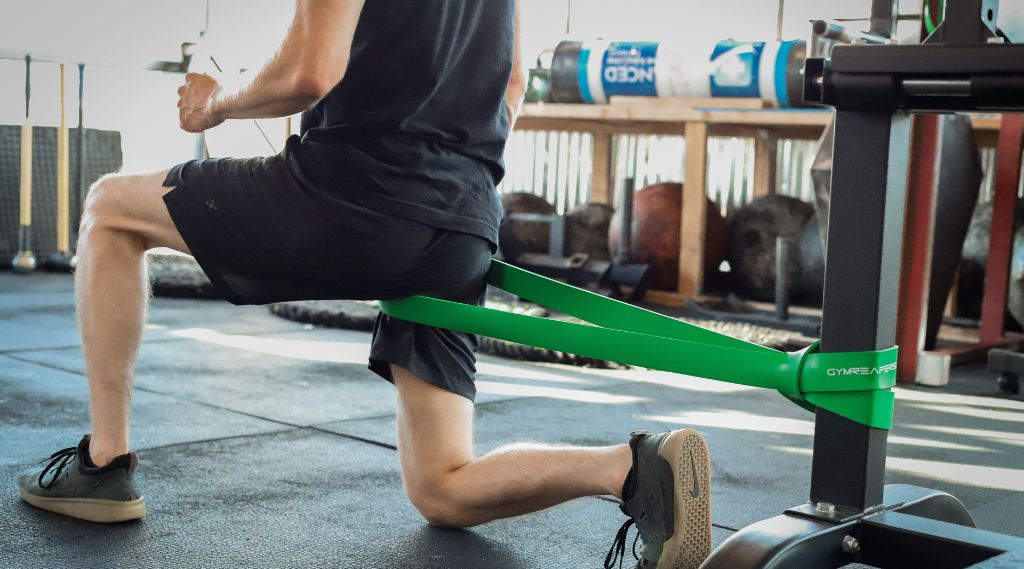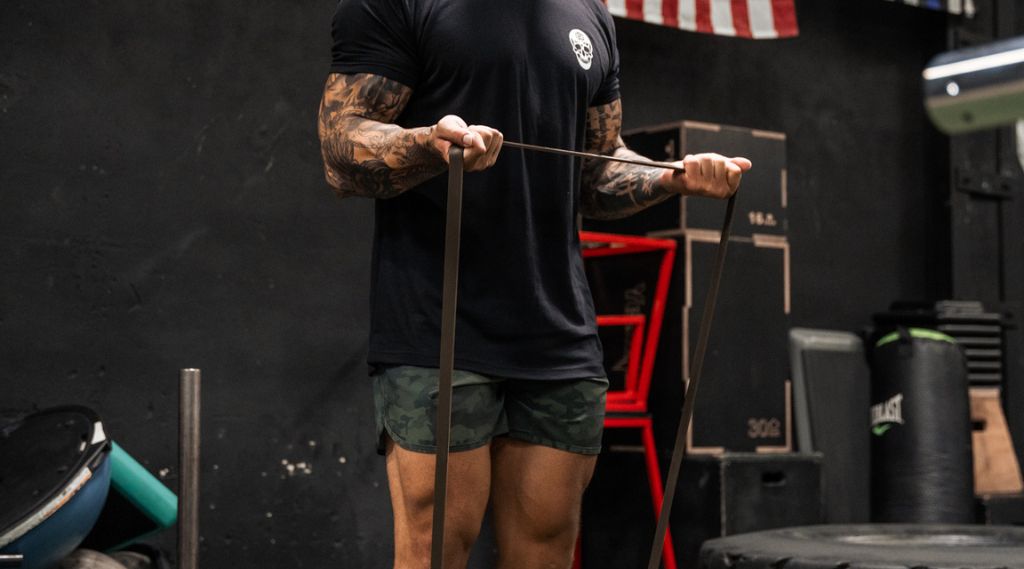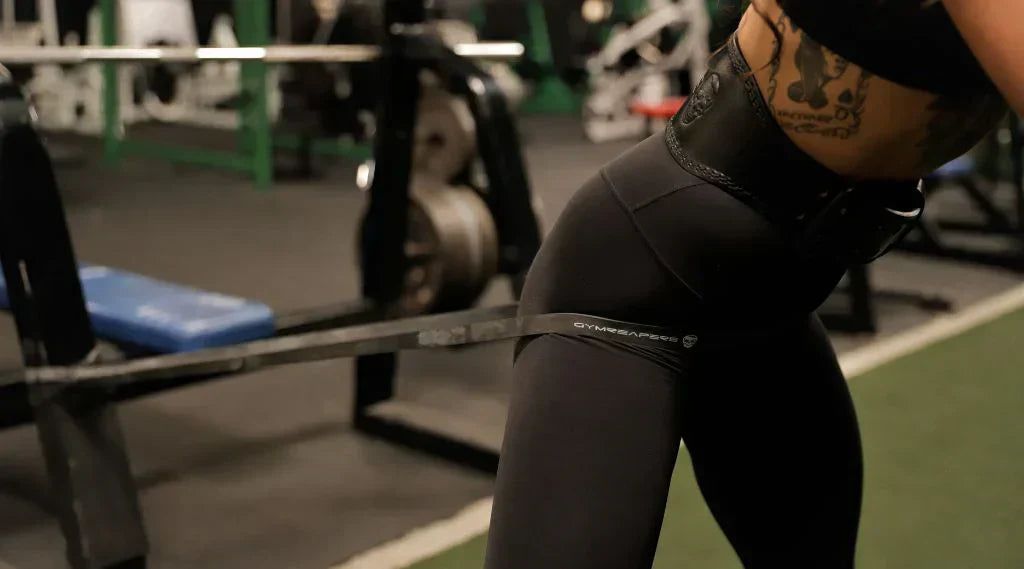Resistance bands are a great tool to use to train the lower body as they allow you to attack the muscle from different angles and at varying intensities.
This is especially helpful when training the adductors because they perform very specific movements.
When using bands to train the adductors, you want to have a wide variety of resistance levels as different exercises require levels. Any movement that requires you to pull the thighs toward your midline against resistance will target the adductors, as well as very deep squats.
In this article, I’ll discuss the anatomy of the adductor muscles, why you should train them with bands, and offer you my top band adductor exercises. Plus, I’ll share a sample adductor workout you can do with resistance bands to get you started.
Anatomy of the Adductor Muscles

The adductors are a group of smaller muscles that run along the inside of the thigh and are responsible for pulling the thighs toward the midline of the body. They also help aid in creating hip stability during most lower-body exercises and movements.
The adductor muscles include:
-
Adductor Magnus: The largest muscle of the adductors and helps abduct the leg as well as flex and internally rotate at the hip.
-
Adductor Longus: The most superficial of the adductor group (Magnus, longus, brevis) and is responsible for helping adduction as well as internal rotation of the hip.
-
Adductor Brevis: This muscle lies between the Magnus (in front) and the longus (under) and is primarily responsible for the adduction of the thigh, however, it also assists in flexion and extension of the thigh as well as external rotation of the hip.
-
Gracilis: This is the muscle most visible as it lies on top of the others, and runs along the entire length of the inner thigh. It is responsible for internal rotation of the thigh as well as flexion.
- Pectineus: This is a smaller muscle that connects high in the thigh to the groin and assists in adduction as well as the flexing of the hip
4 Benefits of Training the Abductors With Bands

If you want to strengthen your adductors then there are 4 benefits to doing so using bands:
1. Reduce Groin Injury Risks. Weak adductors can cause instability at the hip and the knee which can increase your risk of injury, particularly groin pulls and strains.
By strengthening the adductors, you can help protect yourself from injury in the gym, while playing sports, and doing daily activities.
2. Increase Hip Performance. The adductors are responsible for pulling the legs inwards and internally rotating the femurs. If you have a poor internal rotation at the hip, your pelvis will not be able to move as it is intended to.
This can cause restrictions at the hip that prevent you from achieving the safest and strongest positions while squatting, deadlifting, and running. Strengthening your adductors with bands can help prevent restrictions.
3. Improved Balance. The adductors help to create hip stability, especially when on one leg. Weak adductors can create balance problems which can decrease performance, limit progress, and even result in injury to the knees, hips, and lower body muscles.
Strengthening your adductors with bands can help to improve your balance. The improvement in balance can be two-fold when performing standing adductor exercises that require additional balance and stability.
4. Easy to Train Anywhere. Bands allow you to train the adductors without the need for machines or weights.
The ability to vary the resistance based on how much tension you place on the bands (or using different band thicknesses) makes it great for warm-ups, strengthening exercises, and training at home (or throwing some bands in your gym bag).
Related Articles:
- Best Hip Flexor Exercises With Bands
- Best Hamstring Exercises With Bands
- Best Calf Exercises With Resistance Bands
6 Best Adductor Exercises With Bands
Below are six of the best adductor exercises you can do with bands.
1. Standing Leg Adduction
This is an isolation exercise that you can do to target the adductors and is very similar to the cable standing abduction exercise seen in most gyms.
You will need a loop resistance band, like this one, and access to a pole, post, or beam that is sturdy enough to wrap a band around to develop tension (without having that support bend or move).
How To
- Loop a resistance band around a beam or sturdy post (the band should be about 6’ from the ground), and then take your right leg and place it through the loop.
- With the loop around your ankle, take a step away from the post and turn your body so that you are standing 90 degrees from the post.
- With your right leg straight, pull the right leg across your body past your left leg in a crossover motion, feeling the right inner groin muscles (adductors) working.
- Slowly let your right leg return back towards the post, repeat for reps, then switch slides.
Pro Tips
- Make this more challenging by standing further away from the post.
- You should still feel like there is tension in the band when your leg is not being pulled across the body.
2. Banded Copenhagen Plank
The Banded Copenhagen plank is an exercise that trains the adductors isometrically (your muscle contracts without movement). Isometric contractions are great for increasing strength and helping to prepare a muscle for more demanding movements.
This is a great exercise to add to your routine to increase injury prevention.
How To
- You will need to place a heavy resistance band around toe posts or beams. You can also use the J hooks of a squat rack.
- Get in a side plank position, and place your top leg across the band so that the inside of your ankle is resting on the band.
- Apply pressure to the band through the top leg, and try to hold yourself in the side plank without using the bottom leg.
- The band may shake, offering an added instability factor that you will need to overcome.
- Perform this exercise for time, making sure to pull the top leg down towards the ground.
- Once you are done, switch legs.
Pro Tips
- You will want to use a thicker band, like this one, as the goal is to stay up there and hold yourself against the band tension.
- If you cannot perform this with your bottom leg off the ground, try keeping it on the ground, and apply light pressure down into the floor to make this movement easier.
3. Quadruped Banded Adduction
The quadruped banded adduction is similar to the standing leg adduction exercise, however, you will be on the ground in a quadruped position with the knees bent.
By doing this in a quadruped position (on your hands and knees), you can get into a more stable position and train the adductors with heavier loads, which can be helpful if you are looking to increase your adductor strength.
Another benefit to this exercise is that it does not allow you to lean your body or use momentum to cheat.
How To
- Wrap a resistance band around a squat rack or beam, and align yourself so that you are turned 90 degrees from the band when it is lengthened.
- Get in the quadruped position, which is where your knees, hips, and knees are bent at 90 degrees and your hands, knees, and feet are on the floor. Your wrists should be stacked below the shoulders.
- Place the leg that is closest to the band in the loop, with the band resting on the inner thigh/inner knee.
- Move out from the squat rack or beam to develop tension on the band as your leg is slightly lifted outwards.
- Pull the inner thighs together, squeezing the muscles of the inner groin together against the band tension, and then repeat for reps. Then switch sides.
Pro Tips
- Make sure to prevent lower back arching or rounding throughout the movement to isolate the adductors
- Position the hips so that they are level and the lower back is flat, making sure not to lean to the side (leaning away from the band) as you try to pull it inwards.
4. Band-Resisted Adduction Lunge
The band-resisted adduction lunge is a lunge that has you use the bands to apply an outward pulling tension to the lead leg. Due to the band pulling the leg outwards as you do the lunge, the adductors must work to resist that force during the lunge.
This is a great way to train the quads and glutes while also improving adductor strength and hip stability.
How To
- With the band around a squat rack or beam, stand 2-3 feet away and step your inside leg through the loop.
- Turn so that you are facing 90 degrees from the band, making sure that the band is pulling outwards on the inside leg (have the band around the knee or high shin).
- Step backward into a reverse lunge with your left leg, making sure that your right knee bends as your leg knee hits the ground behind you.
- You will feel the band trying to pull the right leg outwards as you lower yourself into the lunge.
- Keep the right knee aligned over the right toe as you descend and stand up, performing all reps on that leg before switching legs.
Pro Tips
- Try wrapping a towel around the end of the resistance band for padding, as the band can be uncomfortable as it rubs along the inside of the thigh. This will also help that band stay in place as you change levels going up and down in the reverse lunge.
- Slow the movement down and focus on resisting the band and keeping the knee in line, this will increase time under tension and challenge the adductors even more.
5. Banded FFE Bulgarian Split Squat
Deep squatting has been shown to target not only the quads and glutes but also the adductors.
Research has shown that subjects who did full squats (140 degrees of knee flexion, which is “ass to grass depth” vs. 90 degrees on knee flexion half squats) had significantly more muscle growth than half squat groups, with ~ 6% more adductor growth.
With bands, the only way to get deep enough and still have good tension is to do single-leg work, as you can load the resistance on the working leg while also elevating the front foot. By elevating the front foot, you can sit lower into a split squat to place the working knee into deeper ranges of motion.
How To
- You will need a bench, a resistance band, and something to elevate your front foot. Aim to find something sturdy that is 2-4” thick that you can place your foot on (books, wood blocks, a step, a bumper plate, etc.).
- Place one end of the loop resistance band under your right foot, and then place the right foot on the elevated platform.
- Take the other end of the resistance band, loop it over your head, and have it resting on the left shoulder.
- With the bench 2-3 feet behind the front foot, place your left foot on the bench behind you.
- Descend into a deep split squat with your weight in the lead leg.
- Stand up and repeat, then switch sides
Pro Tip
Ensure that you are keeping your chest and torso upright, as this will help you place tension on the resistance band upward. If you allow your chest to fall forward and the hips to shoot back, you will place less emphasis on the adductors and more on the glute and lower back.
6. Banded Sumo Squat
Banded sumo squats are done with a wide stance and toes pointed outwards, which allows you to sit into a squat with the thighs pulled apart. By doing a squat with this wide, flared stance, you place more stretch and tension on the inner groin muscles (adductors).
When doing this with a band, you will need to make sure that you can properly secure the band under both feet and then over your upper back.
How To
- Take as wide of a stance as you can take while still being able to squat down to below parallel (more than 90 degrees of knee flexion).
- Stand on one side loop resistance band, with the toes pointed outwards and in a wide stance.
- Take the other side of the loop resistance band and pull it over your head and rest it along your upper back (like a barbell squat).
- Sit as low as you can, as the lower the squat, the more adductors you will get, and then stand up and repeat for reps.
Pro Tip
Make sure your thighs are open and your knees are pointed in the same direction as your toes (pointed outwards about 30-45 degrees) when you squat. You want to align the knees and toes so that you minimize stress on the knee joint.
Sample Adductor Workout Routine With Bands

Below is a sample adductor workout routine you can do with bands.
Note: training the adductors, especially on a lower body workout can result in intensive soreness, as they are smaller muscle groups that aid larger ones, and therefore are typically not trained with as much volume and intensity as the quads, hamstrings, or glutes.
- Standing Leg Adduction: 3 sets of 15-20 reps per leg, use this as a warm-up, focusing on slow and controlled movements, resting minimally between legs.
- Banded FFE Bulgarian Split Squat: 3 sets of 12-15 reps per leg, resting 60-90 seconds between sets
- Banded Coppenhangan Plank: 3 sets of 30-45 seconds per leg, resting 60-90 seconds between sets
Best Bands For Training Your Adductors
When looking for resistance bands for your adductor training, you want to make sure you have a variety of resistance bands.
Isolation exercises for the adductors should be done with lighter bands, whereas more compound movements like sumo squats and Bulgarian split squats can be done with heavier bands.
Below are the best bands (and band accessories) for your adductor training.
Resistance Band Set (20-150 lbs)

The Gymreapers complete resistance band set is a great value that offers you different levels of resistance to train all the exercises listed above appropriately.
By having 5 different resistance band levels, ranging from 20-150lbs, you can better customize your intensity levels based on the movements you are doing. You can also progress your training over time by moving up to a more difficult band.
The bands are made from durable latex, which means they will not snap easily and will last you a very long time. They even come in a bag that you can easily store them between workouts, or throw them into your Gymreapers gym bag.
Ankle Straps

The Gymreapers ankle straps are ideal for standing leg adductions. Since standing leg adduction is one of the best ways to directly target the adductors with bands, it will be a staple in all adductor programs.
By having the ankle straps, you do not need to worry about the band moving around as you lift your leg, which can be annoying as you start to get sweaty and push the intensity.
The Gym Repeater ankle straps can be used by men and women. These are constructed from durable and breathable neoprene, making them comfortable and even sweat-resistant. These are perfect for calf training as well as lower-body exercises.













Leave a comment
All comments are moderated before being published.
This site is protected by hCaptcha and the hCaptcha Privacy Policy and Terms of Service apply.